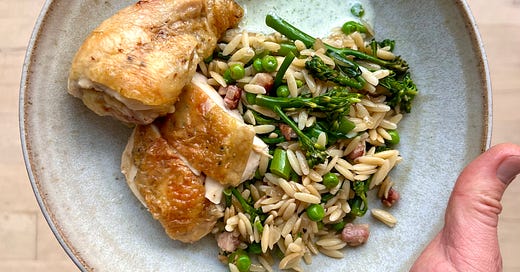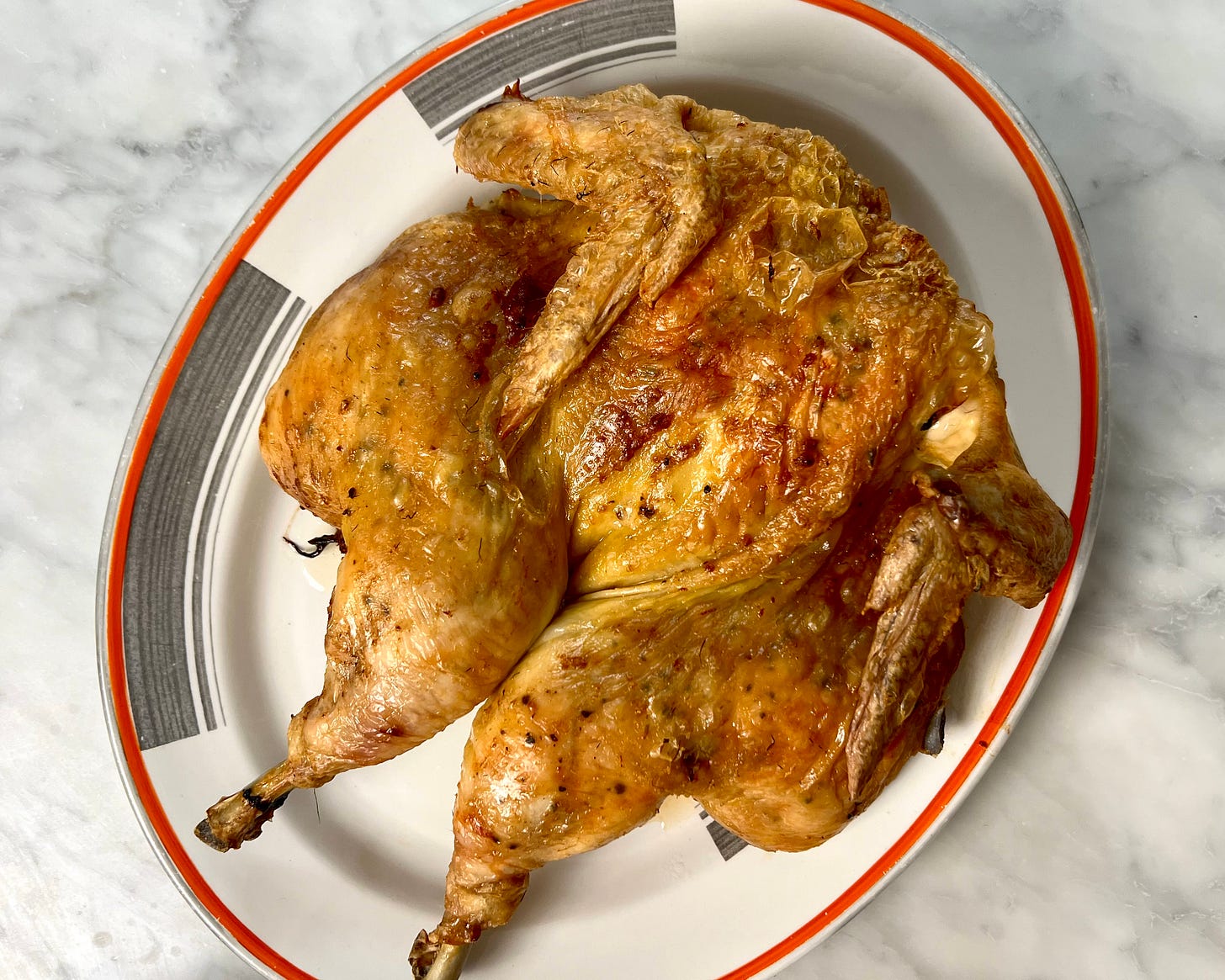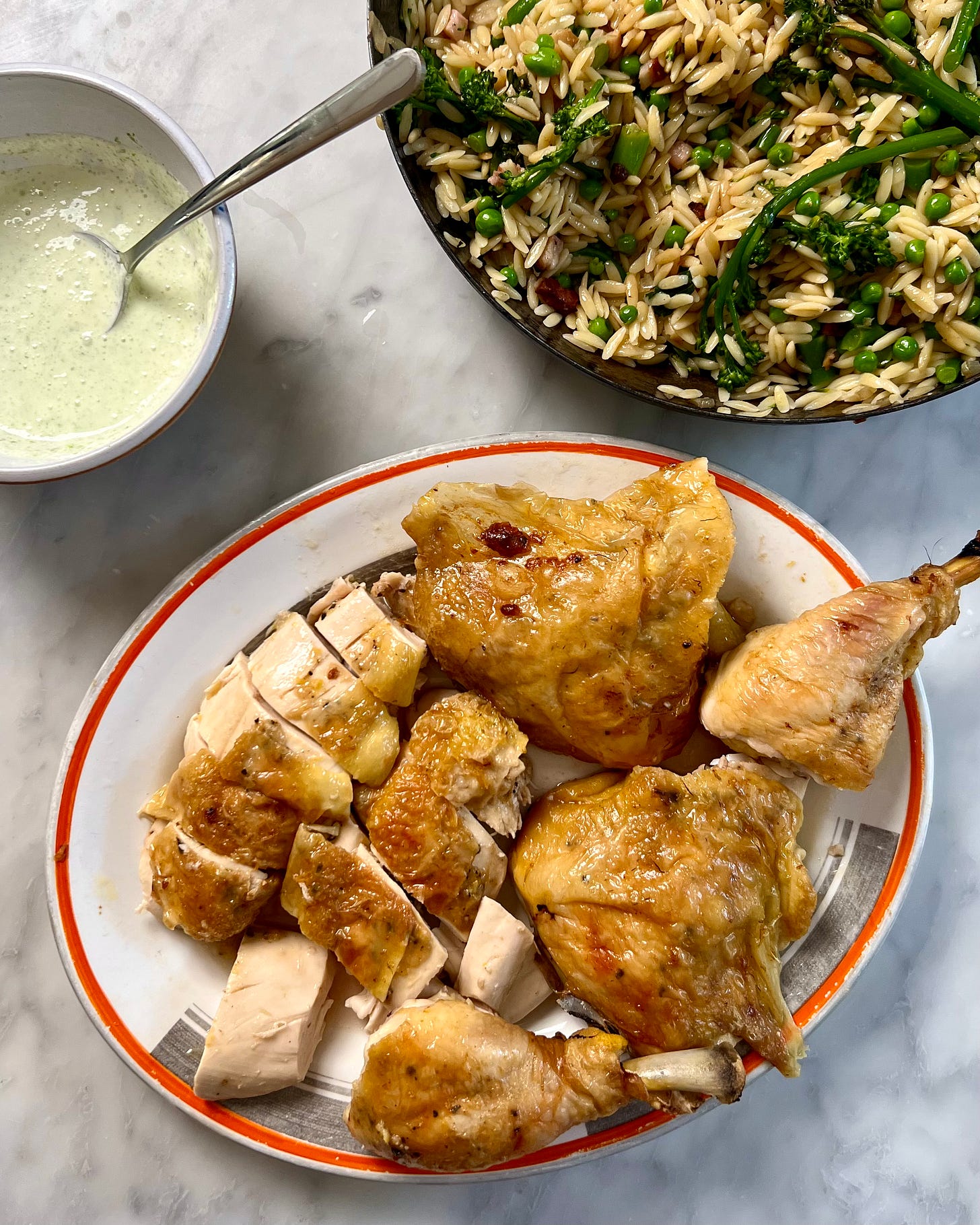In The Centre #1 | Spatchcocked chicken
With a black pepper, lemon and Parmesan butter (and other good things)
This is a sample of the kind of recipe you can expect on Rocket & Squash, A Cook's Digest. While you’re here, please take a look around the rest of Rocket & Squash.
Although some content will always remain free, a portion of newsletters will only be available to supporters of Rocket & Squash. If you would like to receive all weekly newsletters and new recipes, and to view the archive without restriction, then simply upgrade to a paid membership. For this introductory period, that costs just £4.50 a month / £45 a year.
(Small monthly/annual fee —> recipes, words, Oxford commas, and my eternal love.)
In The Centre
This is the first Rocket & Squash newsletter labelled ‘In The Centre’. As it happens, that makes it the final sample of the four ‘columns’ that’ll form the core of this Digest, with the plan being to rotate them week by week — the other three are ‘On the Side’, ‘Tomato Pasta’, and ‘Supplemental’. The R&S landing page is now set up so that you can easily browse by theme.
The purpose of In The Centre is, ultimately, to provide you with a recipe for a mighty yet highly cookable centrepiece dish (the clue was in the name).
Sometimes that will be an all-in-one meal. But if (as today) the primary element needs or would be neatly complemented by specific sides or condiments, they’ll be in here too. Where appropriate (again, as today), there’ll also be a short dive into the what, why and how.
The dishes will typically require a touch more effort than a tray bake. They might even require a little shopping, preparatory work, or a new-to-you technique. However they’ll rarely, if ever, amount to a full-on, capital P project. Sometimes they’ll be sweet, but more often than not savoury. Whatever the focus, I hope you enjoy reading about and cooking them.
What and why spatchcock
Man I love a spatchcocked and then roast chicken.
If you’re not familiar with the term, spatchcocking is where a chicken (or other poultry) is ‘butterflied’ by the removal of its backbone, and the breaking and squashing of its breastbone. This allows the bird to be sat flat, legs coquettishly splayed.
The benefit of preparing a chicken like this is that the different parts of the bird cook (a) speedily and (b) miraculously evenly. Meaning that the leg and wing meat reaches the necessarily high temperature to transform collagen to gelatin (around 83C), ensuring these harder working and potentially rubbery muscles are tender, before the breast meat is overcooked and dry. This equilibrium is far harder to execute where a bird is trussed and roast in its natural, unflattened form.
Golden and blistered skin, succulent flesh, uncommonly generous juices, all relatively speedily achieved. What is not to love?
How to spatchcock
For anyone squeamish, it’s fairly easy to get hold of an already spatchcocked chicken — certainly in the UK, many supermarkets stock birds that have been prepared in this way, and every butcher should do it on request.
For anyone who’s not squeamish, then this is an extremely simple process that’s worth trying once. You’ll then do it again and again.
The bird
Buy the best chicken you can afford. Although please, for this recipe, at the very least make it free range. This is an ethics point. But, to be honest, it’s also a matter of flavour and suitability. Lower welfare chicken tend to be flabby with little legs. The watery breast meat puffs-up exaggeratedly, the legs don’t benefit in the same way as those that have actually been used, and and the thin skin won’t turn uniformly crisp and golden. In fact, if you plan to stuff a flavoured butter under the skin (see below), you’ll find low welfare chicken skin is more likely to rip. Which is annoying.
On a separate note, I find this method is best for birds weighing 1.4-1.8kg (without giblets). With a strong preference for lighter end of that range where possible. The method isn’t so satisfying where chickens are heavier. (Admittedly, big chickens freak me out.)
The butchery
In short: use sturdy scissors to cut along either side of the backbone and remove it (save it for stock). Flip the chicken over and remove the wishbone. Then sit the chicken open side down, place two palms on the breast bone, and use your body weight to push the bird flat, breaking the breast bone as you do so.
In long:
sit the chicken as you would normally expect, with the domed, breast-side up (conversely, the legs are closer to the surface it is sat on). Now then turn it over. This flatter side is where the backbone is.
Beginning at the soft, stubby ‘parsons nose’, use your chunkiest scissors to cut either side of the narrow bone (2-3cm wide), working from one end of the chicken to the other. Remove this bone and either use it for stock. Or if that’s not going to happen, find a dog, or the food waste bin.
The opposite end to the legs is the neck end. Its opening looks a bit like a v. Use a small knife to scrape away a thin layer of flesh covering bone either side of the v, then the tip of that knife to cut along the other side of the bone (the wishbone), as close to it as possible. This helps to release it. Twist that bone at its apex, and pull away from the bird.
Sit the chicken open side down. Place two palms on the ridge of the bird (the breast bone) and use your body weight to push the bird flat, breaking the breast bone as you do so. Your chicken is now spatchcocked.
In rough and ready video:
Seasoning and cooking
For seasoning, there are two options:
rub the skin with oil or butter and add a generous sprinkle of salt; or
separate the skin from the flesh — both the breast meat and leg areas — and shove a flavoured butter between the two.
Herby butters are OK, although the softer fresh herbs are subject to such a heat that they lose their potency and become a relatively unappealing darkened lump. Finely chopped rosemary or dried oregano are typically the most effective option.
In any event, to my mind, butters laced with spices and/or citrus zest are best. Think cumin, turmeric, black pepper, paprika, mustard powder, chilli flakes spice blends like baharat or curry powders. There’s an ‘nduja butter spatchocked chicken in my book Crave. See also the black pepper, lemon and Parmesan butter recipe in this post. The methodology includes a video of the skin separation and stuffing technique.
What to eat alongside?
In theory this is simply a roast chicken. It’s just one that’s been flattened. So whatever you’d normally enjoy with that…
And yet, personally, when serving up this particular style of chook, I rarely feel the need to be constrained to the sides I’d serve in the context of a British Sunday Roast.
If you get it right (hint: follow the method and timings below), then the result is most akin to French rotisserie or Portuguese/South African peri peri chicken.
So it needs just a few simple things: something starchy (that’ll soak up the juices), something verdant, and perhaps a pop of flavour from an additional salad or bright vegetable. Plus a punchy condiment.
Potatoes. You do you. But for this I like: French fries; sauté potatoes; boulangere potatoes; or roast potatoes (at a push — matching oven timing and temperature is relevant).
Small pasta shapes, such as orzo or fregola (also known as mograbia or giant couscous), or grains like bulgar wheat.
Butter beans, chickpeas or rice also good.
Sharply dressed green or bitter leaf salad (butterhead lettuce; cos; baby gem; rocket; watercress; radicchio; chicory).
Or if it’s cold, then a big pile of blanched or steamed green things: cavolo nero and kale work well, particularly if part of a medley with sweeter greens such as peas, tenderstem and purple sprouting brocolli, asparagus or green beans.
Sweet and sharp bright things: corn on the cob; roasted peppers; basic (but good) tomato salad.
For the condiment: romesco sauce; aioli; a hot sauce or salsa; tzatziki; or another yoghurt-based sauce. Not something too oily, though. There’ll be plenty of fatty juices coming from the chicken.
The Recipe
Lemon, black pepper and Parmesan butter chicken
with tarragon yoghurt, plus glossy orzo and greens
This chicken, with its golden skin and ridiculously juicy and succulent leg and breast meat is fantastic on its own. There’s a hint of Parmesan, lemon zest and pepper under the skin, and a more of all those things in the pan juices too. French fries and a bitter leaf salad would work perfectly well.
However, the simple side and sauce suggested here enrich and elevate the chicken higher still.
Fat and slippery grains of orzo mingle with smoky pancetta and the sweet pop of brocolli and peas, plus a significant glug of fragrant roasting juices.
In addition, the thin sauce — a sharp combination of tarragon, yoghurt and vinegar — cuts through all the buttery richness quite magnificently, while simultaneously binding everything together (tarragon being such a good friend of chicken, broccoli and peas).
If you can’t picture it, or need convincing, this video provides an additional teaser.
The recipe continues…







